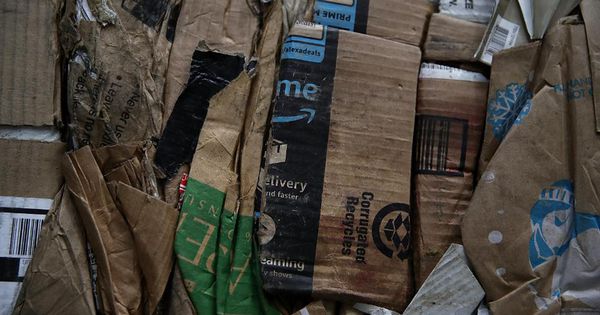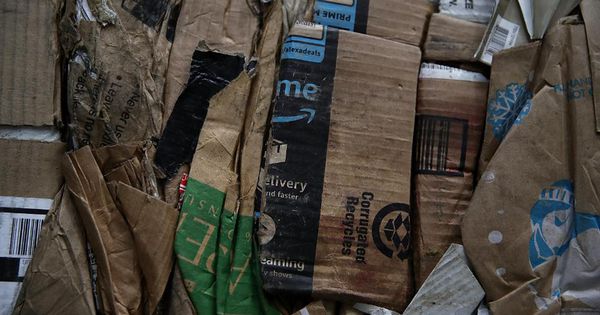
Americans love online retail – the channel grew by 16% last year in the US, while all retail rose 3.8%. We love the speed and convenience. We love the ‘just-got-a-gift’ feeling of boxes turning up on our doorstep. We love Amazon too – one fan back in 2014 remarking, “I’m in a monogamous relationship with #amazonprime.” But love, as they say, is blind. And as consumers, we turn a blind eye to the environmental cost of online retail, particularly when it comes to packaging.
SAN FRANCISCO, CA – JANUARY 04: Amazon Prime boxes are seen in a bundle of recycled cardboard at Recology’s Recycle Central on January 4, 2018 in San Francisco, California. (Photo by Justin Sullivan/Getty Images)
As reported in Fast Company, about 165 billion packages are shipped in the US each year, with the cardboard used roughly equating to more than 1 billion trees (that’s billion with a ‘b’). If you look specifically at meal-kits, category leader Blue Apron sends out around 8 million meals a month, each one containing two six-pound ice packs. The freezer pack waste is about 192,000 tons per year, or, as Mother Jones noted, “the weight of nearly 100,000 cars or 2 million adult men.”
BOSTON, MA – JUNE 28: In this photo illustration, a Blue Apron box sits on the porch of a house on June 28, 2017 in Boston, Massachusetts. (Photo by Scott Eisen/Getty Images)
Generally speaking, we are drowning in a sea of packaging waste, and too much of it is ending up in the ocean. A recent campaign from Lonely Whale and Point Break Foundation claims that by the year 2025, there will be 1 tonne (a metric ton) of plastic for every 3 tonnes of fish in the ocean. (It gets worse – the United Nations tells us that by 2050 there will be more plastic waste than fish.) Online retail is certainly not responsible for all that trash – but it sure doesn’t help.
An article by Pam Baker on “E-commerce packaging waste becoming a bigger issue” helps to unpack the problem. Prior to the Internet, the logistics for traditional retail were simple and linear – goods were shipped in bulk to a warehouse and then to the store. The system for e-commerce is much more complex, and involves many more hands. As a 2017 white paper entitled “Optimizing Packaging for an E-commerce World” reminds us, e-commerce has about four times as many touch-points as regular retail, and shipments are broken down into individual packages for delivery.
Retailers also want to ensure that goods arrive in perfect condition – and that can result in over-packaging. The average box is “dropped 17 times”, according to ANAMA Package and Container Testing owner, Anton Cotaj. So that’s why you can receive a small package inside a relatively large box filled with “air-bags”. It means that the retailer is literally “shipping air”, as the director of packaging program at Rutgers University, Hae Chang Gea, puts it. Effective, but wasteful.
It seems that both shoppers and retailers are starting to wake up to the packaging issue. Consumers are getting the guilts. A 2016 New York Times article chronicles the “guilt and frustration” and sheer embarrassment of recycling all those boxes as part of the “cardboard economy”. Amazon has a “Frustration-Free Packaging Program” designed to “produce less waste and put an end to ‘wrap rage’.” Envelopes have replaced boxes for smaller shipments, and a system has been introduced to ship products in their original packaging, rather than doubling up. Amazon also asks constantly for “packaging feedback” after shipping items, and if a comment is sufficiently pointed, will pull “the Andon cord” to stop a product from letting down another customer. Amazon claims to have cut nearly a quarter of a million tons of packaging materials from 2007 to 2017, “avoiding 500 million shipping boxes”.
Other big retailers appear to be similarly motivated – no doubt partially to anticipate backlash. Walmart has a “Sustainable Packaging Playbook”. In China, e-comm giant Alibaba and L’Oreal are partnering on “green packaging”. (Watch this space: brand and retailer packaging partnership initiatives will start coming thick and fast.)
Start-ups are popping up in the field of responsible packaging. Limeloop is pioneering durable shipping pouches that are recycled from billboard wraps and intended to be reused as many as 2,000 times. Co-founder Ashley Etling says it is “essential we reimagine the packaging experience” for an e-commerce economy. A European company called Repack not only promotes re-use but has a reward model, offering an incentive for customers to return the packaging rather than toss it in the trash.
Other entrepreneurs are opening outlets boasting zero waste. Lauren Singer, author of the blog “Trash is for Tossers” has set up Package Free Shop, which ships completely plastic free, re-using the boxes they have in their inventory. Ex-Amazon employee Tamara Lim is establishing The Wally Shop, with fresh food items to be delivered in reusable containers.
Package Free Shop, Brooklyn, NYJon Bird
Online retail is only going to get bigger. Amazon alone sold 100 million products on Prime Day, and shipped over 5 billion items through Prime last year. Brand-owners, retailers and plain old consumers alike all need to take responsibility for reducing the packaging impact on the environment. Otherwise, just as in Pixar’s Wall-E, we will wind up suffocating in garbage.

